Related Research Articles

Francisco Franco Bahamonde was a Spanish general who led the Nationalist forces in overthrowing the Second Spanish Republic during the Spanish Civil War and thereafter ruled over Spain from 1939 to 1975 as a dictator, assuming the title Caudillo. This period in Spanish history, from the Nationalist victory to Franco's death, is commonly known as Francoist Spain or as the Francoist dictatorship.

The Falange Española de las Juntas de Ofensiva Nacional Sindicalista, was a fascist political party founded in Spain in 1934 as merger of the Falange Española and the Juntas de Ofensiva Nacional-Sindicalista. FE de las JONS, which became the main Fascist group during the Second Spanish Republic, ceased to exist as such when, during the Civil War, General Francisco Franco merged it with the Traditionalist Communion in April 1937 to form the similarly named Falange Española Tradicionalista y de las JONS.
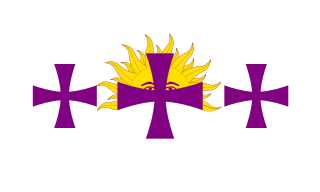
Hispanidad is a Spanish term alluding to the group of people, countries, and communities that share the Spanish language and Hispanic culture. The term can have various, different implications and meanings depending on country of origin, socio-political views, and cultural background.
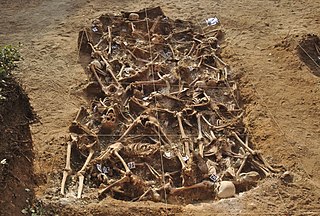
In the history of Spain, the White Terror describes the political repression, including executions and rapes, which were carried out by the Nationalist faction during the Spanish Civil War (1936–1939), as well as during the first nine years of the regime of General Francisco Franco. In the 1936–1975 period, Francoist Spain had many official enemies: Loyalists to the Second Spanish Republic (1931–1939), Liberals, socialists of different stripes, Protestants, intellectuals, homosexuals, Freemasons, Romanis, Jews, and Basque, Catalan, Andalusian and Galician nationalists.

The creation of the tradition of the political community of Spaniards as common destiny over other communities has been argued to trace back to the Cortes of Cádiz. Revisiting the history of Spain, after 1812 Spanish liberalism tended to take for granted the national conscience and the Spanish nation.
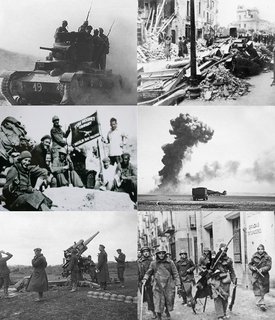
The Spanish Civil War was a civil war in Spain fought from 1936 to 1939 between the Republicans and the Nationalists. Republicans were loyal to the left-leaning Popular Front government of the Second Spanish Republic, and consisted of various socialist, communist, separatist, anarchist, and republican parties, some of which had opposed the government in the pre-war period. The opposing Nationalists were an alliance of Falangists, monarchists, conservatives, and traditionalists led by a military junta among whom General Francisco Franco quickly achieved a preponderant role. Due to the international political climate at the time, the war had many facets and was variously viewed as class struggle, a religious struggle, a struggle between dictatorship and republican democracy, between revolution and counterrevolution, and between fascism and communism. According to Claude Bowers, U.S. ambassador to Spain during the war, it was the "dress rehearsal" for World War II. The Nationalists won the war, which ended in early 1939, and ruled Spain until Franco's death in November 1975.
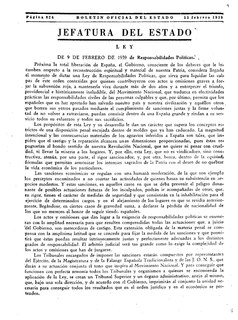
The Law of Political Responsibilities was a law issued by Francoist Spain on 13 February 1939 two months before the end of the Spanish Civil War. The Law targeted all loyalist supporters of the Second Spanish Republic and penalized membership in the Popular Front of the defeated republic.

The Nationalist faction or Rebel faction was a major faction in the Spanish Civil War of 1936 to 1939. It was composed of a variety of right-leaning political groups that supported the Spanish Coup of July 1936 against the Second Spanish Republic and Republican faction and sought to depose Manuel Azaña, including the Falange, the CEDA, and two rival monarchist claimants: the Alfonsist Renovación Española and the Carlist Traditionalist Communion. In 1937, all the groups were merged into the FET y de las JONS. After the death of the faction's early leaders, General Francisco Franco, one of the members of the 1936 coup, would head the Nationalists throughout most of the war and emerge as the dictator of Spain until his death in 1975.
The Spanish 1977 Amnesty Law is a law promulgated by the Parliament of Spain in 1977, two years after caudillo Francisco Franco's death. The law freed political prisoners and permitted those exiled to return to Spain, but also guaranteed impunity for those who participated in crimes, during the Civil War, and in Francoist Spain. The law is still in force, and has been used as a reason for not investigating and prosecuting Francoist human rights violations.

The Sección Femenina was the women's branch of the Falange political movement in Spain. Founded in July 1934 as part of the Sindicato Español Universitario (SEU) of the Falange Española de las JONS, and fully incorporated to FE de las JONS later in the year, it remained as part of the FET y de las JONS following the 1937 Unification Decree, subsequently becoming an official institution of the single-party of the Francoist dictatorship. Following General Franco's death and the beginning of the transition to democracy it was disbanded on 1 April 1977 together with all Movimiento Nacional institutions. Sección Femenina was led throughout its history by Pilar Primo de Rivera, the younger sister of Falange Española founder José Antonio Primo de Rivera.

Feliu Elias i Bracons was a Catalan caricaturist, painter and critic.
Miriam Margarita Basilio Gaztambide is an American art historian and Associate Professor of Museum Studies and Art History at New York University. Basilio's intellectual interests include Latin American art, political art, and other issues of politics, art, and identity.
Women in Francoist Spain found traditional Catholic Spanish gender roles being imposed on them, in terms of their employment opportunities and role in the family. For Republican women, Francoist Spain was a double loss, as the new regime first took away the limited political power and identities as women which they had won during the Second Spanish Republic (1931-1939), and it secondly forced them back into the confines of their homes. Motherhood would become the primary social function of women in Francoist Spain.
Prostitution in the Spanish Civil War was part of a larger ideological battle about the role of women and race. Opposition to it came from both first-wave feminists and fascists, who would often have connections to beliefs about racial purity in their condemnation of prostitution. Accusations of prostitution would also be made to damage political and social enemies.
Women in POUM in Francoist Spain were few as many, along with male dominated leadership, were forced into exile following the end of the Spanish Civil War. Those in exile often felt isolated and alone. Those who remained were sometimes sent to prison. POUM women participated in a hunger strike at Madrid's Las Ventas prison in 1946. The group fell by the wayside as Partido Comunista de España became the pre-dominant resistance organization in Spain. The organization finally dissolved during the 1950s in Toulouse, France with its memory kept alive by the wife of its last president, María Teresa Carbone, through the Fundació Andreu Nin.
Women in CNT in Francoist Spain were persecuted as part of state organized efforts to eliminate remaining leftist elements. Confederación Nacional del Trabajo (CNT) was formed in 1910, and from the onset it did not treat women equally to men inside the organization. This continued during the Second Spanish Republic, the Spanish Civil War and into Francoist Spain.
Women in 1930s Francoist Spain experienced major changes to marriage. Civil marriages that tool place between 1932 and 1939 were annulled, and only if both partners were Roman Catholic were they permitted to remarry.

The mottos of Francoism are mottos which encapsulate the ideals of the Francoist dictatorship. Although the regime had many ideological influences, it employed Falangism in its popular movements. Falangist ideology was easily incorporated in the creation of mottos as it is believed to demonstrate a certain reluctance towards political agendas, and to favour empiricism, taking action, and the simplification of ideas.
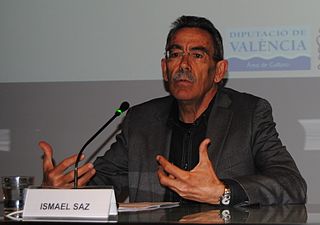
Ismael Saz Campos is a Spanish historian, specialised in the study of Falangism, Francoist Spain and the Spanish-Italian relations during the Spanish Civil War. He is a professor at the University of Valencia.
The Spanish Civil War was fought from 17 July 1936 till the victory of Francoist Spain on 1 April 1939. After the end of the war, the Spanish Republic formed a government-in-exile in Paris and Mexico City. Between the start of the civil war and Spanish transition to democracy and the reconciliation with the Spanish Republican government in exile in 1977, nations decided when, how, and if they recognised the government of Spain.
References
- ↑ Hillgarth, J. N. (1966). "Coins and Chronicles: Propaganda in Sixth-Century Spain and the Byzantine Background". Historia: Zeitschrift für Alte Geschichte. 15 (4): 483–508. JSTOR 4434955.
- ↑ Ramage, Ε S. (1998-02-01). "Augustus' Propaganda in Spain". Klio (in German). 80 (2): 434–490. doi:10.1524/klio.1998.80.2.434. S2CID 164741472.
- ↑ Rhodes, Dennis E.; Walsh, James E. (1986). "Spanish propaganda printed in Venice: Two dialogues by Alfonso de Valdés". Harvard Library Bulletin. New Series.
- ↑ Hardin, Jennifer Roe (2013). Fighting for Spain through the Media: Visual Propaganda as a Political Tool in the Spanish Civil War (Thesis). Boston College. College of Arts and Sciences.
- ↑ Basilio, Miriam (2002). Re-inventing Spain: Images of the nation in painting and propaganda, 1936–1943 (Thesis). OCLC 53234858.
- ↑ Basilio, Dr Miriam (2014-01-17). Visual Propaganda, Exhibitions, and the Spanish Civil War. Ashgate Publishing, Ltd. ISBN 978-1-4094-6481-5.
- ↑ Greeson, Helen (2012-05-11). Gendering the Republic and the Nation: Political Poster Art of the Spanish Civil War, 1936-1939 (Thesis).
- ↑ Basilio, Miriam (2002). "Genealogies for a New State: Painting and Propaganda in Franco's Spain, 1936-1940". Discourse. 24 (3): 67–94. doi:10.1353/dis.2003.0030. S2CID 143243878. Project MUSE 48707.
- ↑ Ruiz, Beatriz Correyero (2003-01-01). "La propaganda turística española en los años del aislamiento internacional". Historia y Comunicación Social (in Spanish). 8: 47–61.